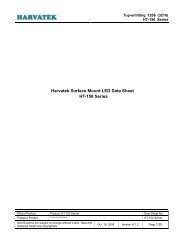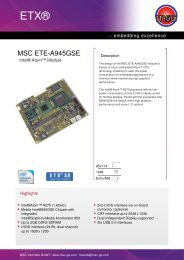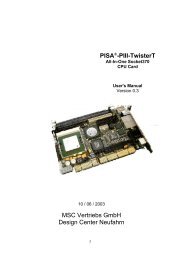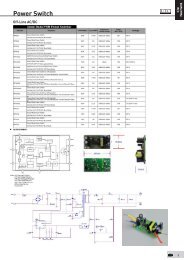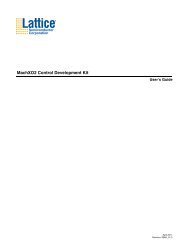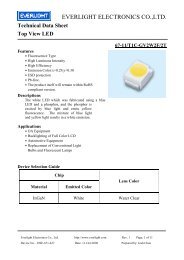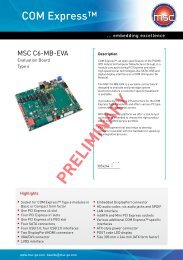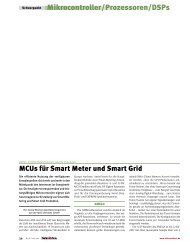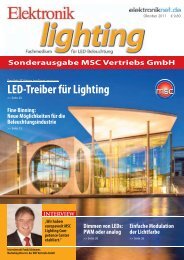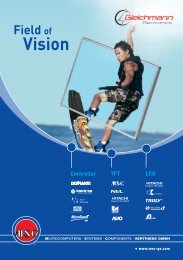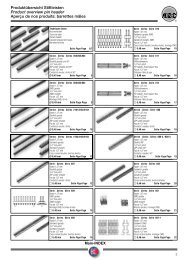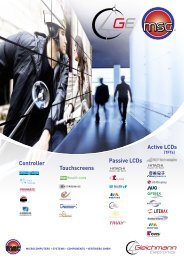ADC 10-bit 2 Gsps Evaluation Board - TSEV83102G0B User Guide
ADC 10-bit 2 Gsps Evaluation Board - TSEV83102G0B User Guide
ADC 10-bit 2 Gsps Evaluation Board - TSEV83102G0B User Guide
Create successful ePaper yourself
Turn your PDF publications into a flip-book with our unique Google optimized e-Paper software.
1.3 <strong>Board</strong><br />
Mechanical<br />
Characteristics<br />
Overview<br />
The board’s layer number, thickness, and functions are given below, from top to bottom.<br />
Table 1-1. <strong>Board</strong>’s Layer Thickness Profile<br />
Layer Characteristics<br />
Layer 1<br />
Copper layer<br />
Layer 2<br />
RO4003 dielectric layer<br />
(Hydrocarbon/Wovenglass)<br />
Layer 3<br />
Copper layer<br />
Layer 4<br />
BT/Epoxy dielectric layer<br />
Layer 5<br />
Copper layer<br />
Layer 6<br />
BT/Epoxy dielectric layer<br />
Layer 7<br />
Copper layer<br />
Layer 8<br />
BT/Epoxy dielectric layer<br />
Layer 9<br />
Copper layer<br />
Layer <strong>10</strong><br />
BT/Epoxy dielectric layer<br />
Layer 11<br />
Copper layer<br />
Copper thickness = 40 µm<br />
AC signal traces = 50Ω microstrip lines<br />
DC signal traces (B/GB, GAIN, DIODE, OA, TEST, SDA)<br />
Layer thickness = 200 µm<br />
Dielectric constant = 3.4 at <strong>10</strong> GHz<br />
-0.044 dB/inch insertion loss at 2.5 GHz<br />
-0.318 dB/inch insertion loss at 18 GHz<br />
Copper thickness = 39 µm<br />
Ground plane = reference plane 50Ω microstrip return<br />
Layer thickness = 330 µm<br />
Copper thickness = 35 µm<br />
Power and ground planes<br />
Layer thickness = 330 µm<br />
Copper thickness = 35 µm<br />
Power and ground planes (identical to layer 5)<br />
Layer thickness = 330 µm<br />
Copper thickness = 35 µm<br />
Ground planes (identical to layer 3)<br />
Layer thickness = 200 µm<br />
Copper thickness = 35 µm<br />
Power and ground planes<br />
The TSEV83<strong>10</strong>2G0B is an eleven layer PCB made of six copper layers and five dielectric<br />
layers. The six metal layers correspond respectively from top to bottom to the AC<br />
and DC signals layer (layer 1), two ground layers (layers 3 and 5), and one supply layer<br />
(layer 7).<br />
Considering the severe mechanical constraints due to the wide temperature range and<br />
the high frequency domain in which the board is to operate, it is necessary to use a<br />
sandwich of two different dielectric materials, with specific characteristics:<br />
� A low insertion loss RO4003 Hydrocarbon/Wovenglass dielectric layer of 200 µm<br />
thickness, chosen for its low loss (-0.318 dB/inch) and enhanced dielectric<br />
consistency in the high frequency domain. The RO4003 dielectric layer is dedicated to<br />
the routing of the 50Ω impedance signal traces (the RO4003 typical dielectric<br />
constant is 3.4 at <strong>10</strong> GHz). The RO4003 dielectric layer characteristics are very close<br />
to PTFE in terms of insertion loss characteristics.<br />
� A BT/Epoxy dielectric layer of 0.9 mm total thickness which is sandwiched between<br />
the upper ground plane and the back-side supply layer.<br />
TSEV83<strong>10</strong>2G0B - <strong>Evaluation</strong> <strong>Board</strong> <strong>User</strong> <strong>Guide</strong> 1-3<br />
2166D–BDC–01/04



